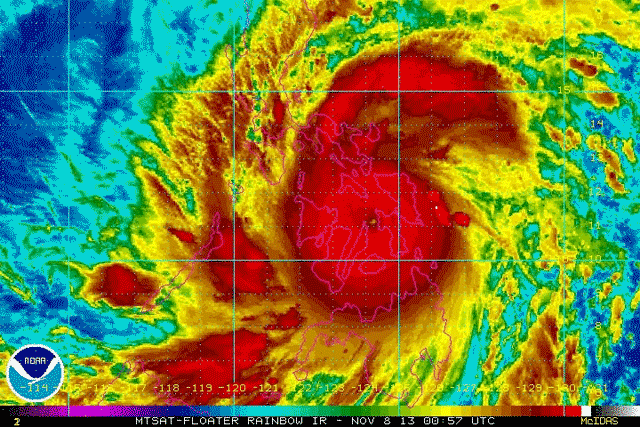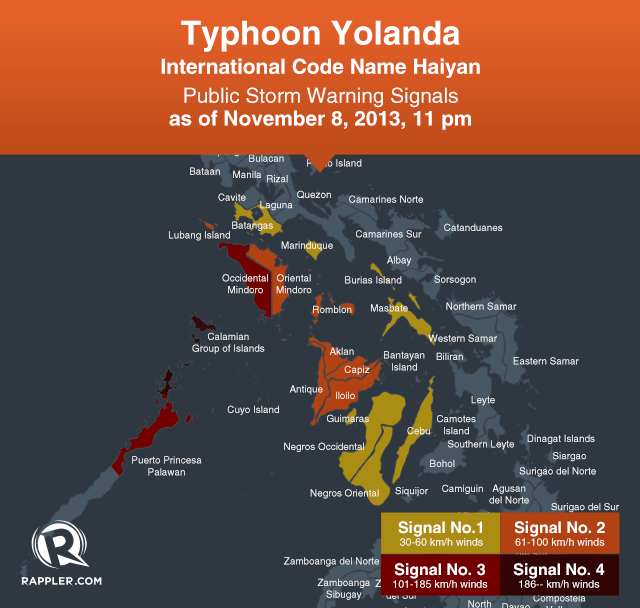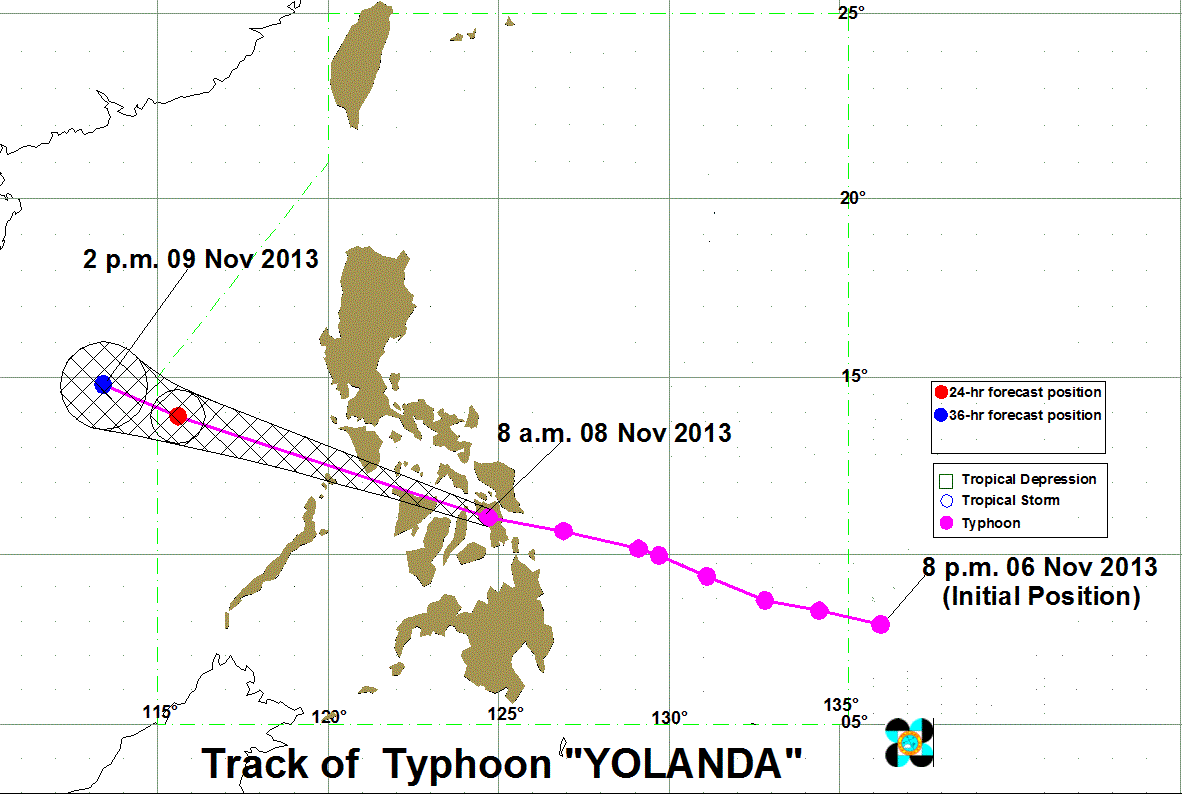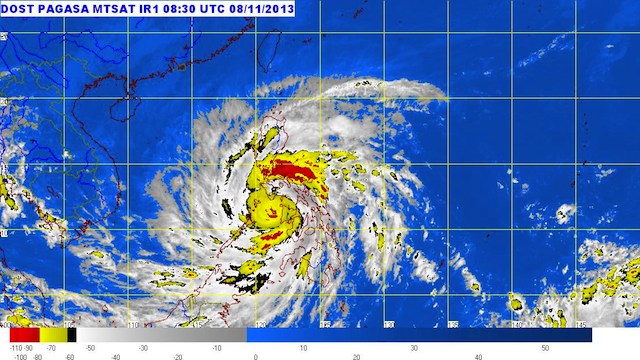SUMMARY
This is AI generated summarization, which may have errors. For context, always refer to the full article.

MANILA, Philippines (UPDATED) – Super typhoon Yolanda (international codename Haiyan) has slightly weakened as it makes its way out of the Philippines.
As of 10 pm on November 8, its maximum sustained winds are at 195 kilometers per hour near the center, down from 215 km/h recorded by state weather bureau PAGASA’s 5 pm severe weather bulletin. However, it still packs gusts up to 230 km/h.
The eye of Yolanda was located 30 km west of Coron, Palawan. It is expected to exit the Philippine Area of Responsibility around 2 pm Saturday, November 9.
The system is still carrying heavy to intense rainfall (10-20 mm/h) within the 400 km inside diameter of the storm. In total, PAGASA said the typhoon has a 600-km diameter.

Storm warning signal number 4, where winds of more than 185 km/h is expected within 12 hours, is in effect over these areas:
- Extreme northern Palawan
- Calamian Islands
The following areas are under storm warning signal number 3, where winds between 101-185 km/h will be felt within 18 hours:
- Occidental Mindoro
- The rest of northern Palawan
- Puerto Princesa City
Signal number 2 is in effect over these areas:
- Romblon
- Cuyo Island
- Oriental Mindoro
- Biliran
- Lubang Island
- Aklan
- Iloilo
- Capiz
- Antique
Here, winds between 61-100 km/h is expected within 24 hours.
Areas under signal number 1, meanwhile, are the following:
- Masbate
- Marinduque
- Batangas
- Burias Island
- Negros Provinces
- Guimaras
- Cebu
Winds between 30-60 km/h are expected within 36 hours.
Elsewhere, public storm warning signals have been lifted, the bureau said.

The typhoon first smashed into the coastal communities of Samar and Leyte, with the center of the year’s strongest weather disturbance making its first landfall over Guiuan, Eastern Samar with maximum sustained winds of at least 235 km/h near the center and gusts of up to 275 km/h.
It then made landfall 5 times, island-hopping from Eastern Samar to Leyte, then to the northern tip of Cebu, onward to Bantayan Island and Panay.
It is currently moving west northwest at a speed of 40 km/h over the Sulu Sea, and is expected to pass near Busuanga on its way out of the Philippine landmass.
The bureau also assured the public that the storm won’t curve back towards the Philippines, since there are no other weather systems that could block its current projected path.
3 dead, widespread damage
One of the most intense typhoons on record, Yolanda killed at least 3 people and terrified millions as monster winds tore roofs off buildings and giant waves washed away flimsy homes.
“We’ve had reports of uprooted trees, very strong winds… and houses made of light materials being damaged,” Philippine Red Cross chief Gwendolyn Pang told Agence France-Presse on Friday afternoon.
The government said 3 people had been confirmed killed and another man was missing after he fell off a gangplank in the central port of Cebu.
But the death toll was expected to rise, with authorities unable to immediately contact the worst affected areas and Yolanda only expected to leave the Philippines in the evening.
“The winds were so strong that they flattened all the banana plants around the house,” university student Jessa Aljibe, 19, told Agence France-Presse by telephone from the Samar city of Borongan shortly after Yolanda made landfall.
All telephone contact to the island was later lost as the typhoon moved inland.
“We have put rescue teams and equipment at different places, but at the moment we can’t really do much because of the heavy rain and strong winds. There is no power,” said Pang, the Red Cross official.
Among most powerful storms on record

Yolanda’s wind strength made it one of the 4 most powerful typhoons ever recorded in the world, and the most intense to have made landfall, according to Jeff Masters, the director of meteorology at US-based Weather Underground.
Yolanda generated wind gusts of 379 km/h on Friday morning, according to the US Navy’s Joint Typhoon Warning Center.
Masters said the previous record for the strongest typhoon to make landfall was Hurricane Camille, which hit Mississippi in the United States with sustained winds of 190 miles an hour in 1969.
The US expert said he expected the damage in Guiuan to be “catastrophic.”
Communication lines with Guiuan remained cut off in the afternoon, and the civil defense office said it was unable to give an assessment of the damage there.
In Tacloban, corrugated iron sheets were ripped off roofs and floated with the wind before crashing into buildings, according to video footage taken by a resident.
Flash floods also turned Tacloban’s streets into rivers, while a photo from an ABS-CBN television reporter showed 6 bamboo houses washed away along a beach more than 200 km to the south.
More than 125,000 people in the most vulnerable areas had been moved to evacuation centers before Yolanda hit, according to the national disaster management council, and millions of others huddled in their homes.
Authorities said schools in the storm’s path were closed, ferry services suspended and flights cancelled. – With reports from KD Suarez and Agence France-Presse/Rappler.com
Add a comment
How does this make you feel?
There are no comments yet. Add your comment to start the conversation.